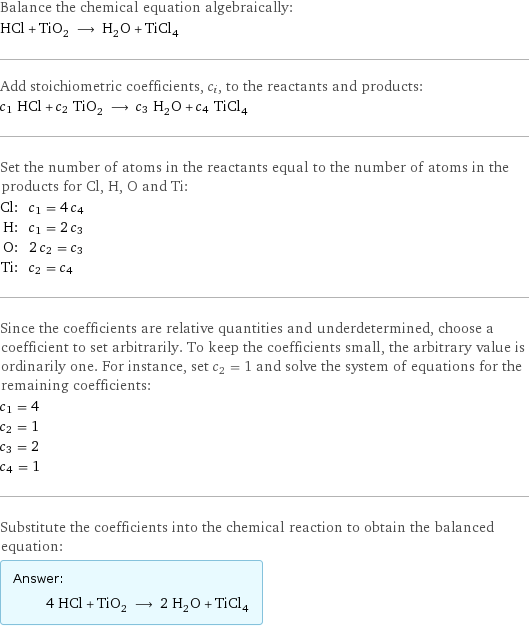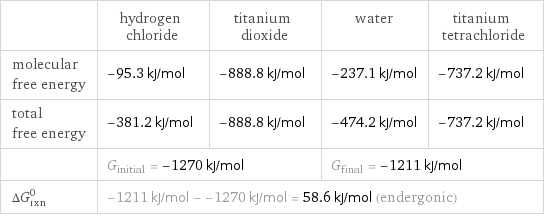Input interpretation

HCl (hydrogen chloride) + TiO_2 (titanium dioxide) ⟶ H_2O (water) + TiCl_4 (titanium tetrachloride)
Balanced equation

Balance the chemical equation algebraically: HCl + TiO_2 ⟶ H_2O + TiCl_4 Add stoichiometric coefficients, c_i, to the reactants and products: c_1 HCl + c_2 TiO_2 ⟶ c_3 H_2O + c_4 TiCl_4 Set the number of atoms in the reactants equal to the number of atoms in the products for Cl, H, O and Ti: Cl: | c_1 = 4 c_4 H: | c_1 = 2 c_3 O: | 2 c_2 = c_3 Ti: | c_2 = c_4 Since the coefficients are relative quantities and underdetermined, choose a coefficient to set arbitrarily. To keep the coefficients small, the arbitrary value is ordinarily one. For instance, set c_2 = 1 and solve the system of equations for the remaining coefficients: c_1 = 4 c_2 = 1 c_3 = 2 c_4 = 1 Substitute the coefficients into the chemical reaction to obtain the balanced equation: Answer: | | 4 HCl + TiO_2 ⟶ 2 H_2O + TiCl_4
Structures

+ ⟶ +
Names

hydrogen chloride + titanium dioxide ⟶ water + titanium tetrachloride
Reaction thermodynamics
Gibbs free energy

| hydrogen chloride | titanium dioxide | water | titanium tetrachloride molecular free energy | -95.3 kJ/mol | -888.8 kJ/mol | -237.1 kJ/mol | -737.2 kJ/mol total free energy | -381.2 kJ/mol | -888.8 kJ/mol | -474.2 kJ/mol | -737.2 kJ/mol | G_initial = -1270 kJ/mol | | G_final = -1211 kJ/mol | ΔG_rxn^0 | -1211 kJ/mol - -1270 kJ/mol = 58.6 kJ/mol (endergonic) | | |
Equilibrium constant
![K_c = ([H2O]^2 [TiCl4])/([HCl]^4 [TiO2])](../image_source/dc133e5b327d651bcf0eae2313c8dc28.png)
K_c = ([H2O]^2 [TiCl4])/([HCl]^4 [TiO2])
Rate of reaction
![rate = -1/4 (Δ[HCl])/(Δt) = -(Δ[TiO2])/(Δt) = 1/2 (Δ[H2O])/(Δt) = (Δ[TiCl4])/(Δt) (assuming constant volume and no accumulation of intermediates or side products)](../image_source/2b81b83b638c249ebc07eb842ce5e9f0.png)
rate = -1/4 (Δ[HCl])/(Δt) = -(Δ[TiO2])/(Δt) = 1/2 (Δ[H2O])/(Δt) = (Δ[TiCl4])/(Δt) (assuming constant volume and no accumulation of intermediates or side products)
Chemical names and formulas

| hydrogen chloride | titanium dioxide | water | titanium tetrachloride formula | HCl | TiO_2 | H_2O | TiCl_4 Hill formula | ClH | O_2Ti | H_2O | Cl_4Ti name | hydrogen chloride | titanium dioxide | water | titanium tetrachloride IUPAC name | hydrogen chloride | | water | tetrachlorotitanium